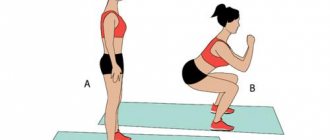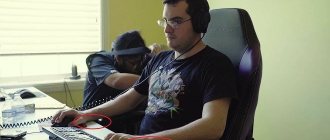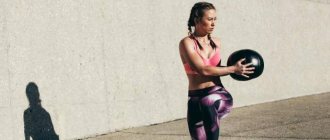Hello Friend! Today we’ll talk about fitness, which will help not only your figure get back to normal, but also your adorable baby will absolutely love it!
Spring is in full swing, which means it's time to start preparing your figure for the summer season! Almost your entire wardrobe is the spring-summer 2013 fashion trend, but what about your figure? How are you going to fit into a new ultra-stylish swimsuit when imperfections in shape are so obvious!
Do you remember just recently we told you about morning jogging for weight loss? We hope that you are already used to getting up earlier than usual, and you are not embarrassed by 30-minute runs through the parks.
But you must admit that this type of fitness, although very useful, is still not suitable for everyone! For example, what to do if there is no park or stadium near your home? What if you get up for work at such a time of day that there is no time left for a run?
In this case, diets will come to your aid! Some of them will help you lose weight faster, while others will take a little more time. But even here you won’t be satisfied with diets alone, forgive the pun. Any diet is good if you have:
- the willpower to endure it all and finally lose weight;
- presence of physical activity.
The two above requirements are mandatory for your figure to return to its former luxurious shape, and for the extra pounds to scatter in all directions in fear.
Today I will tell you about 5 wonderful exercises that you can do right at home! All these exercises will not require the makings of an athlete from you and will not take much time, and your figure will again become ideal.
A nice addition: all the proposed exercises can be performed with the baby, which is very important when the child is still very small and the mother’s fitness classes are a weak excuse for her absence.
Fitness with your baby at home!
Your baby will help you get in shape after childbirth! Instructor Svetlana Litvinova and her seven-month-old daughter Alena show what exercises can be performed with him in pairs.
The child will be delighted with the game and communication with his mother. And at the same time, he will begin to join the movement and enjoy it.
Paired training is very beneficial for both the child and the mother. In fact, they begin the moment a mother holds her baby in her arms for the first time. By lifting him, turning him over, squatting with him to pick up a diaper that has fallen to the floor, you are already doing the simplest exercises with “Weights,” says instructor Svetlana Litvinova, a mother of two children. -. This is a soft, natural load, for which there are no contraindications and which, as required in fitness, gradually increases.”

You can adapt the most common push-ups, squats and crunches for paired exercises with your baby (before deliberately starting training, it is better to consult a doctor. For example, in the original exercise for push-ups from your knees, place the child on the floor between your palms. Each time, lowering yourself towards the baby, make a face at him, blow lightly in his face, kiss him.
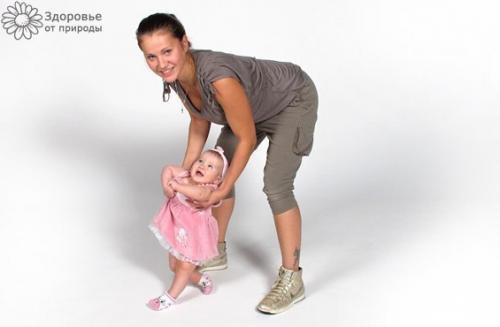
“The child will be delighted with the game, with communication with his mother,” says Svetlana Litvinova. - and at the same time, he will slowly begin to join the movement and enjoy it. His vestibular apparatus will develop well. And if you conduct classes with music, then the sense of rhythm will also come.”
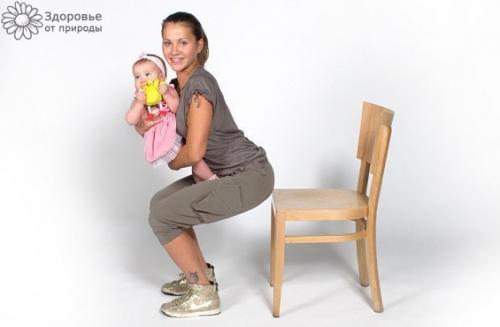
The exercises that Svetlana suggests are best done with children 3-12 months old. As long as the child does not hold his head well, it will be difficult to work with him. And when he already walks confidently, you can’t force him to sit on your hands.

It’s better to train according to your mood – to suit your own and your child’s mood. “Don’t get hung up on doing all the exercises at once, in combination,” advises Svetlana. - if the baby is tired and begins to be capricious, take a break. You can generally break this workout into elements and perform them one at a time during the day: in the morning - “Swings”, in the afternoon - squats, after sleep - “children’s lift”…. Perform each as many times as is comfortable for you and your child (preferably 10-15 times.
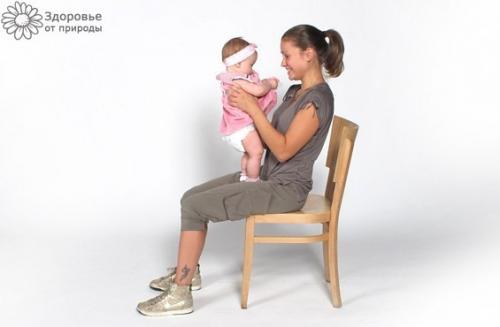
Use any free minute for fitness when the child is in a good mood and ready to play. If the child does not like some movements, replace them with others. And don't be afraid that your training performance will suffer because of this. After all, it is not designed to pump up your abs to six-pack abs or your arms to athletic definition. She has a different task: to tone the muscles, strengthen them and prepare them for more serious loads. And she copes with this task “Excellently”. I tested this on myself.”
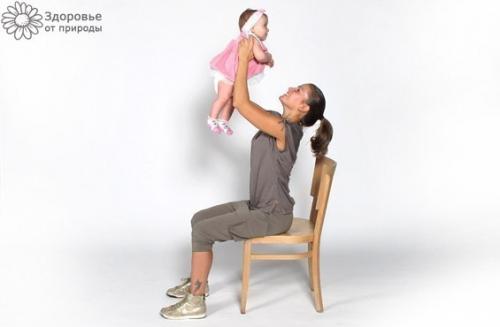
Lunges with a baby.

Strengthens the muscles of the thighs and buttocks. Take the child in your arms, turn his back to you, hug and press. Take a wide step forward with your right foot. Bend your knees and lower yourself into a lunge. Make sure that the shin of your right leg is perpendicular to the floor, and point your left knee towards the floor. Return to starting position and repeat.

Hugging squats.
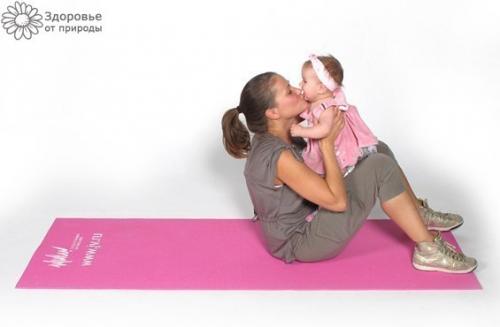
Strengthens the muscles of the thighs and buttocks. Take the child in your arms, hug and hold him close. Stand in front of a chair with your back to the seat. Tighten your abdominal muscles, keep your back straight. Squat down, moving your buttocks back. Once you touch the seat, slowly return to the starting position and repeat.
"Children's Lift".
Strengthens the muscles of the shoulders, upper back, biceps. Take the child in your arms and sit on a chair, knees bent, feet on the floor. Turn your baby to face you and hold him at approximately chest level, elbows bent. Tighten your abs and lift your baby a little by straightening your arms. Blow into his face, return to the starting position and repeat.
"Swing".
Strengthens the abdominal muscles. Sit on the floor, knees bent, feet on the floor. Place your baby's stomach on your shins and support him from the sides. Roll onto your back, lifting your feet off the floor and lifting your baby above you. Return to starting position and repeat.
Crunching with your baby.
Strengthens the abdominal muscles. Take your baby and lie on your back. Knees bent, feet on the floor. Place your baby on your stomach so that he leans his back against your thighs - leaning back, like in a chaise lounge. Hold it from the sides. Raise your body, reach out to the baby, smile and blow on the face or kiss. Slowly return to the starting position and repeat.
Weighted squats.
Relieves back muscles. Practice a position that will help you save your back from overload. When leaning towards a child, for example, supporting him by the arms when he learns to walk, do not round your back, but, leaving it straight, bend your knees. When lifting your child, do not “pull” the weight with your back. Squat down, grab your baby, and stand up straightening your knees as if you were doing barbell squats.
How to do fitness at home with your child! My step by step experience!
Continuing the topic of fitness at home (first post here), I shared my recipes, how and what I did directly!
You can view the post via the link above, or go to the subtitle! I just didn’t post photos there!
Not long ago I touched upon the topic of fitness at home, which often causes more skepticism than inspiration among many, and if you consider that the toddler also “helps” in this matter, then for some such exercises seem impossible at all.
In this article, I want to debunk this myth using personal experience as an example and prove that fitness at home with a child is not only possible, but also fun.
The statement that everything was cloudless and my daughter immediately and easily allowed me to throw myself into the maelstrom of various fitness trends would look like an outright discrepancy with reality on my part, in other words, a lie!
We didn’t arrive at almost cloudless training straight away, but gradually each of us established some rules that we more or less follow!
I am eternally grateful to my daughter for the opportunity to devote up to 50 minutes to training (my workouts are different, some are short (for example, I devote 10 minutes to gymnastics for the face), there are medium ones - 30-40 minutes each), but a full-fledged yoga class, no matter how Cool, it takes at least 50 minutes).
Next, I will try to summarize my approach to establishing home fitness when you are the mother of a small child.
I clearly remember my first workout: I started with a banal press exercise, to which I devoted 10-15 minutes. By that time, my daughter was already half a year old, and she had just learned to crawl. Laying her on a blanket spread on the floor with a developmental mat, I began the exercises. At first she looked at me in surprise, lying down, and then she went to explore the room, crawling around me. “Cool!”, I thought, I can gradually increase the pace of training.
My first yoga practice after giving birth (I started practicing it for the first time half a year before pregnancy) was during my daughter’s sleep. Still, it was necessary to give the body the opportunity to remember the technique of performing the main asanas without “observers”, one way or another requiring attention! In other words, you had to listen to yourself and understand what had changed and where to move next. Having discovered that my abdominal muscles could not lift my body without lifting my legs off the floor, I was somewhat perplexed. They also say that if the abs were trained, then they will quickly return to normal after childbirth. I don’t know about you, but in my case this theory was not confirmed.
Thus, in the future, I tried to wake up in advance and at least half of the training took place with me while my daughter completed her journey through the kingdom of Morpheus. Then she moved to my floor, where her attention was more or less captured by the toys. Sometimes during breathing exercises in the Sukhasana pose (known to everyone as “Turkish”), I would take her in my arms and that’s how we combined breastfeeding and yoga. In this case, the interpretation of such joint exercises was more of a free nature, but we felt so good, so such deviations from generally accepted rules were sometimes allowed.
Functional training turned out to be the most difficult for us. If my previous classes were smooth in nature, then here a fairly active pace was required, and the range of movements was such that wow. We are talking about all kinds of lunges, squats, push-ups and other strength exercises with your own weight. My daughter didn’t like it - she was worried, looking at my “acrobatic sketches”, and even cried. I tried to put her in a crib or playpen during classes, again remaining in her sight, but this did not help. I quickly lost the desire to insist on my own, seeing her tears. The decision came spontaneously - at some point I decided to just pick her up and, having simplified the exercises a little, performed them with her in my arms. She was very amused by it, and I liked it too.
There was a period when I even got a little carried away by belly dancing, which I devoted time to while my daughter was sleeping. Still, they require a lot of coordination and for safety reasons it is better to do them without the baby.
As my daughter grew older (closer to one year old), my active training stopped making her nervous, and I was allowed to exercise exclusively while she was awake. Of course, there were breaks: to change my pants, to give me some water, or something else, but on the whole these were full-fledged training sessions.
There were moments when she required unconditional attention, but, as a rule, they were justified by physical ailments.
I want more cartoons to distract my daughter’s attention during my classes. She was given the opportunity at these moments to be independent and engage in toys, books and any other activities that did not threaten her safety.
I remember that she was periodically attacked by a mania for cleanliness and, taking a wet napkin, she rubbed everything that came to hand. Even the mother, who was at that moment in a variety of positions, was subjected to these shamanic rituals. She could also pour some water into her pot, which is still not used for its intended purpose, and wash me with it.
The following three points deserve special attention, which significantly add pleasant bonuses to the already diverse range of emotions.
1. As soon as I lie down in “Shavasana” (a pose in the supine position), which ends most yogic sessions, my daughter lies on my stomach and in this modified Shavasana we plunge into relaxation, listening to ourselves and each other. True, incidents do happen: lying on your back and doing exercises in this position is sometimes required in the middle of a workout, but for my daughter it’s like a kind of signal that the long-awaited moment has arrived and I have to use all my eloquence to convince her otherwise. Sometimes it works, sometimes it doesn't. In the second case, there is a short pause in the lesson, after which it successfully resumes.
2. I began to notice that my little one was trying to repeat some poses or exercises. The “Downward Facing Dog” pose looks especially hilarious in her performance!
She also likes to squat to the beat and raise her arms up while inhaling and exhaling.
3. In addition to our joint shavasana with my daughter, it happens that she has a need to simply express her love for me - she leans towards me and kisses or hugs, and at such moments it is better not to interfere with this, but to satisfy sudden attacks of tenderness.
This is how my daughter and I do fitness at home, and the results make me more and more happy!
Do you do fitness at home? Share in the comments!
Source of material: MAMoirs. How to enjoy maternity leave and get everything done!
